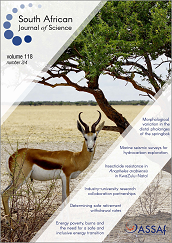Malaria risk and receptivity: Continuing development of insecticide resistance in the major malaria vector Anopheles arabiensis in northern KwaZulu-Natal, South Africa
DOI:
https://doi.org/10.17159/sajs.2022/11755Keywords:
malaria, vector control, risk and receptivity, malaria eliminationAbstract
Malaria incidence in South Africa is highest in the three endemic provinces: KwaZulu-Natal, Mpumalanga and Limpopo. The contribution to malaria transmission by several mosquito species, variation in their resting behaviours and low levels of insecticide resistance makes it necessary to periodically monitor Anopheles species assemblages and resistance phenotypes in vector populations. The aim of this study was therefore to assess Anopheles species assemblage in northern KwaZulu-Natal and to collect insecticide susceptibility data for An. arabiensis, the primary vector of malaria in that province. Anopheles specimens were collected from Mamfene, Jozini, northern KwaZulu-Natal from November 2019 to April 2021. Progeny of wild-collected An. arabiensis females were used for standard insecticide susceptibility tests and synergist bioassays. Anopheles arabiensis contributed 85.6% (n=11 062) of the total catches. Samples for subsequent insecticide susceptibility bioassays were selected from 212 An. arabiensis families. These showed low-level resistance to DDT, permethrin, deltamethrin, and bendiocarb, as well as full susceptibility to pirimiphos-methyl. Synergist bioassays using piperonyl butoxide and triphenyl phosphate suggest oxygenase-based pyrethroid and esterase-mediated sequestration of bendiocarb. These low levels of resistance are unlikely to be operationally significant at present. It is concluded that northern KwaZulu-Natal Province remains receptive to malaria transmission despite ongoing control and elimination interventions. This is due to the perennial presence of the major vector An. arabiensis and other secondary vector species. The continued detection of low-frequency insecticide resistance phenotypes in An. arabiensis is cause for concern and requires periodic monitoring for changes in resistance frequency and intensity.
Significance:
- Insecticide resistance in the major malaria vector Anophelesarabiensis in northern KwaZulu-Natal Province is cause for concern in terms of resistance management and ongoing vector control leading toward malaria elimination.
- Despite ongoing control interventions, northern KwaZulu-Natal remains receptive to malaria owing to the perennial presence of several Anophelesvector species.
Published
Issue
Section
License

All articles are published under a Creative Commons Attribution 4.0 International Licence
Copyright is retained by the authors. Readers are welcome to reproduce, share and adapt the content without permission provided the source is attributed.
Disclaimer: The publisher and editors accept no responsibility for statements made by the authors
How to Cite
- Abstract 1876
- PDF 1175
- EPUB 559
- XML 48
Funding data
-
Bill and Melinda Gates Foundation
Grant numbers OPP1210314 -
International Atomic Energy Agency
Grant numbers SAF 5014/5017, research contract 19099 -
National Research Foundation
Grant numbers 119765, 107428 -
National Health Laboratory Service












.png)